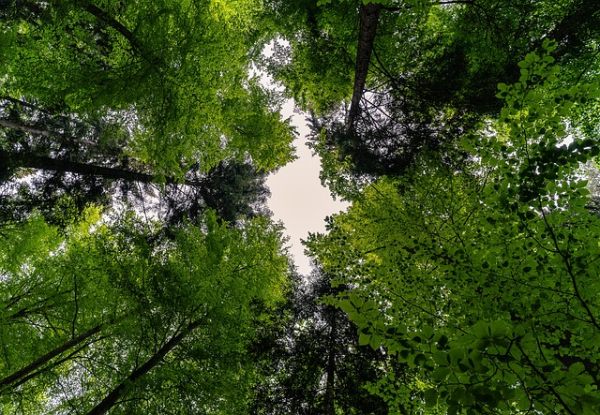From Futurism on 23 March 2024 comes this headline: Trees “Coughing” as They Fail to Capture Excess CO2. The subhead, cleverly, is Wheeze Trees. Here’s the lede: “Trees are ‘coughing’ as they’re struggling to keep up with the sheer amount of heat-trapped carbon dioxide in the air.”
I doubt I need to remind my audience that a single self-reinforcing feedback loop is required to ensure the irreversibility of climate change. I doubt I need to remind my audience that I have identified several dozen such feedback loops, all rooted in the peer-reviewed literature, in an essay I last updated on 2 August 2016. I doubt I need to remind my audience that the Intergovernmental Panel on Climate Change concluded that an overheated ocean ensures the irreversibility of climate change, as indicated in the IPCC’s Special Report on the Ocean and Cryosphere in a Changing Climate. Nonetheless, I just reminded you about all three issues.
The article in Futurism points out “… that in hotter climates, trees are no longer able to help in reducing the harmful effects of human-driven climate change by absorbing excess CO2. Worse yet, they’re releasing considerable amounts of CO2 back into the atmosphere.”
The lead author of a peer-reviewed paper published in the prestigious Proceedings of the National Academy of Sciences is quoted in the Futurism article: “We found that trees in warmer, drier climates are essentially coughing instead of breathing. They are sending CO2 right back into the atmosphere far more than trees in cooler, wetter conditions.”
The article in Futurism correctly summarizes the processes of photosynthesis and photorespiration: “Trees can remove excess carbon dioxide from the atmosphere through photosynthesis, which allows them to grow. But if trees are under stress, they release this gas back into the atmosphere, a process known as photorespiration.”
Obviously, plants and Earth’s climate are inextricably linked. Equally obviously, human actions have irreparably altered the plant-climate relationship. As a result, according to the lead author of the peer-reviewed paper as quoted in the paper in Futurism: “The world will be getting warmer, which means plants will be less able to draw down that CO2.”
Not surprisingly, neither the lead author of the paper in the Proceedings of the National Academy of Sciences nor the paper itself reference another paper in the Proceedings of the National Academy of Sciences. Specifically, a paper published on 10 December 2018 titled Pliocene and Eocene provide best analogs for near-future climates was authored by six scholars. It points out that “climates like those of the Pliocene will prevail as soon as 2030 CE and persist under climate stabilization scenarios.” This conclusion is based on the Intergovernmental Panel on Climate Change’s Representative Concentration Pathways, which ignore all self-reinforcing feedback loops. In other words, a peer-reviewed paper in a prestigious journal published more than five years ago concluded that near-future climate change will be stunningly abrupt.
As I have pointed out previously in this space, even the IPCC concluded that climate change is abrupt and irreversible in two reports published on 8 October 2018 and 24 September 2019, respectively. Those two reports were titled Global Warming of 1.5 Degrees and IPCC Special Report on the Ocean and Cryosphere in a Changing Climate. The latter of these reports was published more than four years ago. Why is this critically important information never reported by the corporate media?
I turn now to the peer-reviewed paper in the Proceedings of the National Academy of Sciences. Authored by eight scholars and published on 6 November 2023, the paper is titled Isotopic clumping in wood as a proxy for photorespiration in trees. The Significance section includes a brief overview of photorespiration: “Photorespiration occurs when, during photosynthesis, plants consume O2 and release CO2 instead of the reverse. How photorespiration varies in the environment today is uncertain but important for validating how climate will change in the future and has changed in the distant past. We develop and apply a proxy for photorespiration rate based on the isotopic composition of a specific function group (methoxyl) in wood. This proxy varies systematically with growing temperature and water availability of trees globally, which suggests that plants in different ecosystems photorespire different amounts and have different physiologic and metabolic responses to climate. Whether plants photorespire more or less in the future and geologic past depends on how local temperature and water availability scale with atmospheric CO2.”
The Abstract includes this important information: “We propose that trees from hotter climates photorespire susbstantially more than trees from cooler climates. How increased photorespiration is managed depends on water availability: water-replete trees export more photorespiratory metabolites to lignin whereas water-limited trees either export fewer overall or direct more to other sinks that mitigate water stress. These disparate trends indicate contrasting responses of photorespiration rate (and thus gross primary productivity) to a future high-[CO2] world.”
That photorespiration is overwhelming photosynthesis is not surprising. After all, we have collectively contributed to an overheated planet. In altering the physical world, we have altered the biological world. In altering the biological world, we have transformed the relationships between ourselves, other organisms, and the physical world. The most important question, in light of these human-caused alterations: How much longer will habitat remain for our species?
Author
"Dr. Guy McPherson is an internationally recognized speaker, award-winning scientist, and the world’s leading authority on abrupt climate change leading to near-term human extinction. He is professor emeritus at the University of Arizona, where he taught and conducted research for twenty years. His published works include 14 books and hundreds of scholarly articles. Dr. McPherson has been featured on TV and radio and in several documentary films. He is a blogger, cultural critic, and co-host of his own radio show “Nature Bats Last.” Dr. McPherson speaks to general audiences across the globe, and to scientists, students, educators, and not-for-profit and business leaders who seek their best available options when confronting Earth’s cataclysmic changes." source







